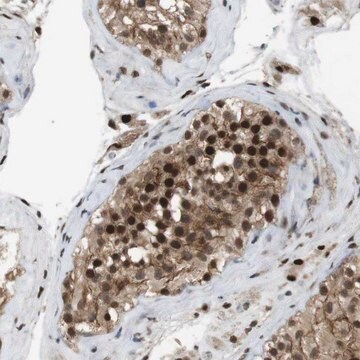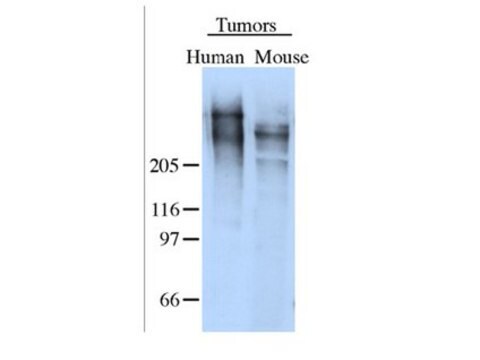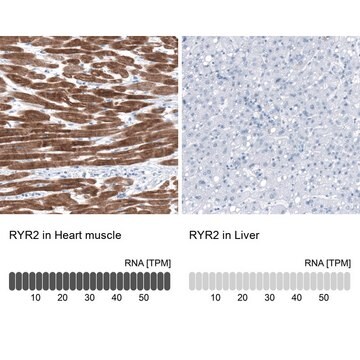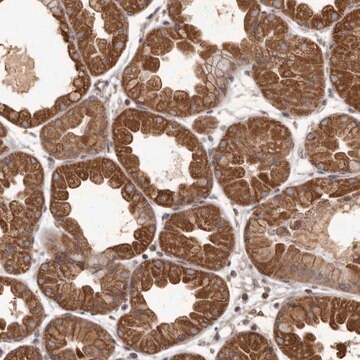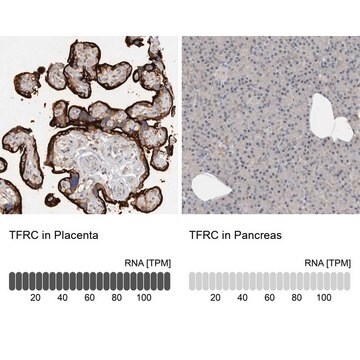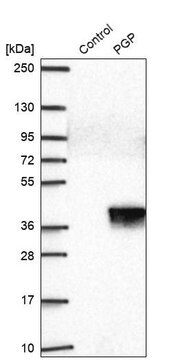推荐产品
生物源
rabbit
品質等級
共軛
unconjugated
抗體表格
affinity isolated antibody
抗體產品種類
primary antibodies
無性繁殖
polyclonal
產品線
Prestige Antibodies® Powered by Atlas Antibodies
形狀
buffered aqueous glycerol solution
物種活性
human
技術
immunohistochemistry: 1:200- 1:500
免疫原序列
DNLLYVWNNYHVVKYSLDFGPLDSRSGQAHHGQVSYISPPIHLDSELERPSVKDISTTGPLGMGSTTTSTTLRTTTLSPGRSTTPSVSGRRNRSTSTPSPAVEVLDDMTTHLPSASSQIPALEESCEAVEAREIMWFKTRQGQIAKQPCP
運輸包裝
wet ice
儲存溫度
−20°C
目標翻譯後修改
unmodified
基因資訊
human ... LPHN3(23284)
一般說明
LPHN3 (latrophilin3) is a G-protein couple receptor (GRPC) belonging to the LPHN family. It is the major LPHN member expressed in brain, especially in cerebellum, cerebral cortex, amygdala, and caudate nucleus. This gene is localized to human chromosome 4q. It has a 19-amino acid leader peptide in its long N-terminal exoplasmic region, and it spans the membrane seven times. It also contains a glycosylation region rich in serine/threonine.
免疫原
adhesion G protein-coupled receptor L3
應用
All Prestige Antibodies Powered by Atlas Antibodies are developed and validated by the Human Protein Atlas (HPA) project and as a result, are supported by the most extensive characterization in the industry.
The Human Protein Atlas project can be subdivided into three efforts: Human Tissue Atlas, Cancer Atlas, and Human Cell Atlas. The antibodies that have been generated in support of the Tissue and Cancer Atlas projects have been tested by immunohistochemistry against hundreds of normal and disease tissues and through the recent efforts of the Human Cell Atlas project, many have been characterized by immunofluorescence to map the human proteome not only at the tissue level but now at the subcellular level. These images and the collection of this vast data set can be viewed on the Human Protein Atlas (HPA) site by clicking on the Image Gallery link. We also provide Prestige Antibodies® protocols and other useful information.
The Human Protein Atlas project can be subdivided into three efforts: Human Tissue Atlas, Cancer Atlas, and Human Cell Atlas. The antibodies that have been generated in support of the Tissue and Cancer Atlas projects have been tested by immunohistochemistry against hundreds of normal and disease tissues and through the recent efforts of the Human Cell Atlas project, many have been characterized by immunofluorescence to map the human proteome not only at the tissue level but now at the subcellular level. These images and the collection of this vast data set can be viewed on the Human Protein Atlas (HPA) site by clicking on the Image Gallery link. We also provide Prestige Antibodies® protocols and other useful information.
生化/生理作用
The exact functional characteristics of LPHN3 (latrophilin3) are not yet understood. In vitro studies show that this protein acts as a receptor for fibronectin leucine-rich repeat transmembrane (FLRT) protein, and this complex might be involved in the glutamatergic synapse development. SNPs in this gene influence metabolism in neuronal circuits, which are involved in attention-deficit/hyperactivity disorder (ADHD). Variants in this gene are associated with susceptibility to ADHD. Studies show that elevated LPHN3 mRNA expression in breast cancer is associated with axillary-node metastasis.
特點和優勢
Prestige Antibodies® are highly characterized and extensively validated antibodies with the added benefit of all available characterization data for each target being accessible via the Human Protein Atlas portal linked just below the product name at the top of this page. The uniqueness and low cross-reactivity of the Prestige Antibodies® to other proteins are due to a thorough selection of antigen regions, affinity purification, and stringent selection. Prestige antigen controls are available for every corresponding Prestige Antibody and can be found in the linkage section.
Every Prestige Antibody is tested in the following ways:
Every Prestige Antibody is tested in the following ways:
- IHC tissue array of 44 normal human tissues and 20 of the most common cancer type tissues.
- Protein array of 364 human recombinant protein fragments.
聯結
Corresponding Antigen APREST72455
外觀
Solution in phosphate-buffered saline, pH 7.2, containing 40% glycerol and 0.02% sodium azide
法律資訊
Prestige Antibodies is a registered trademark of Merck KGaA, Darmstadt, Germany
免責聲明
Unless otherwise stated in our catalog or other company documentation accompanying the product(s), our products are intended for research use only and are not to be used for any other purpose, which includes but is not limited to, unauthorized commercial uses, in vitro diagnostic uses, ex vivo or in vivo therapeutic uses or any type of consumption or application to humans or animals.
未找到合适的产品?
试试我们的产品选型工具.
儲存類別代碼
10 - Combustible liquids
水污染物質分類(WGK)
WGK 1
閃點(°F)
Not applicable
閃點(°C)
Not applicable
Mauricio Arcos-Burgos et al.
Attention deficit and hyperactivity disorders, 2(3), 139-147 (2011-03-25)
During the past 15 years, an impressive amount of genetic information has become available in the research field of psychiatry, particularly as it relates to attention-deficit/hyperactivity disorder (ADHD). However, the classical clinical approach to ADHD has minimally affected and not
M T Acosta et al.
Translational psychiatry, 1, e17-e17 (2011-01-01)
The severity of attention-deficit/hyperactivity disorder (ADHD) symptoms is a major predictor of long-term ADHD outcome. To investigate if two-locus interactions might predict ADHD severity, we studied a sample of 1341 individuals from families clustering ADHD, using the Vanderbilt Assessment Scale
Andreas J Fallgatter et al.
European neuropsychopharmacology : the journal of the European College of Neuropsychopharmacology, 23(6), 458-468 (2012-12-19)
Current research strategies have made great efforts to further elucidate the complex genetic architecture of attention-deficit hyperactivity disorder (ADHD). The present study examined the impact of an LPHN3 haplotype that has recently been associated with ADHD (Arcos-Burgos et al., 2010)
Manas Kotepui et al.
Asian Pacific journal of cancer prevention : APJCP, 13(11), 5879-5882 (2013-01-16)
Breast cancer is the leading cause of cancer deaths among women worldwide, including Thailand. In the present study, the differential mRNA expression of SVEP1, LPHN3, KLB, ITGA7, SEMA3G, TNS1 and MMP13 genes was examined in breast cancer using quantitative real-time
我们的科学家团队拥有各种研究领域经验,包括生命科学、材料科学、化学合成、色谱、分析及许多其他领域.
联系技术服务部门